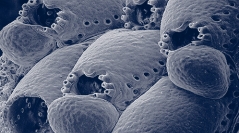

 Zoosystema
45 (10) - Pages 373-407
Zoosystema
45 (10) - Pages 373-407The long-established difference between the bryozoan genera Hemicyclopora Norman, 1894 and Escharella Gray, 1848 is the occurrence of a lyrula in the autozooidal orifices of Escharella species. The examination of abundant material from the Mediterranean and NE Atlantic using re-assessed specific criteria revealed an unexpected diversity involving several undescribed typical Hemicyclopora species, and also species displaying transitional features between the morphological concepts of these two genera. The overall diversity of the examined material comprises ten species with five new species (Hemicyclopora neatonensis n. sp., H. hexaspinae n. sp., “Hemicyclopora” celtica n. sp., “H.” pytheasi n. sp., “Escharella” massiliana n. sp.), and two species of Hemicyclopora left unnamed because of insufficient material. A new genus, Scutocyclopora n. gen., is erected for the Mediterranean species Hemicyclopora dentata López de la Cuadra & García-Gómez, 1991, which diverges in the absence of oral spines and the production of a non-tatiform ancestrula. Six species are distinguished in the Mediterranean material (5-205 m) and seven species in the Atlantic material (128-1050 m). All these species live in deep water, on small, discrete, poorly-lit substrates, mostly of biogenic origin, except for two Mediterranean species (H. hexaspinae n. sp., S. dentata (López de la Cuadra & García-Gómez, 1991) n. comb.), which can also live in dark, shallow submarine caves.
Escharellidae, morphological criteria, species complex, biogeography, scattered microhabitats, stepping-stone dispersal, dark habitats, new combination, new species, new genus